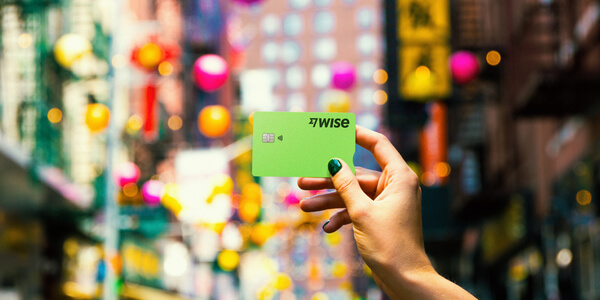Taking cash in or out of Japan: What are the rules?
How much cash can I take to Japan? Read this handy guide for info on the rules for taking cash in and out of Japan.

Planning a trip to Japan from the UK? Whether you’re exploring the bright lights of Tokyo or marvelling at the cherry blossoms in Kyoto, you’ll need to sort out some spending money.
If you prefer to use cash, read on. We’ve put together the essential guide on using ATMs in Japan, so you can withdraw Japanese yen (JPY) whenever you need it. This includes info on where to find ATMs in Japan and tips for keeping fees to a minimum.
We’ll even show you a super convenient way to spend abroad using the Wise card, which works in 150+ countries.
You’ll find ATMs in Japan at major airports, as well as in cities and busy tourist areas. However, not all ATMs will accept cards issued outside of Japan.
So your best bet if you have a UK-issued card is to look for ATMs at post offices and 7-Eleven convenience stores - there are thousands of these spread across the country.1
Foreigner-friendly ATMs are available at international airports and in larger department stores. Aeon Bank ATMs also accept cards issued outside the country.1
To find ATMs in Japan, you can use these ATM locator tools:
Remember - the crucial thing to look for when scouting out ATMs is the word ‘international’.
If you’re travelling to a remote part or island of Japan, bear in mind that there may not be any ATMs (especially not ones that accept foreign cards). So it could be a good idea to plan ahead and take out cash in advance.
ATMs are generally called ATMs in Japan, so you don’t need to worry about any confusing terminology or translations.
They look similar to the cash machines you’ll find in the UK. Just look out for the ‘ATM’ sign.
Many ATMs in Japan will only accept cards issued within the country. This means that you may not be able to use your UK-issued card to withdraw cash.
There are many exceptions though. ATMs at post offices, 7-Eleven and 7 Bank locations, as well as Aeon Bank ATMs, all accept foreign-issued cards. This includes Visa and Mastercard, which are the most commonly issued cards in the UK.
Other major Japanese banks are starting to widen their acceptance of foreign-issued cards at their ATMs, especially in tourist areas.1 But you’ll need to check to find your nearest and make sure it will accept your card.
You can search for your nearest cash machine with these global ATM locators:
Just remember that there’s a chance your card won’t be accepted at every ATM. So, be prepared to try a few, or hunt down a post office or 7-Eleven ATM instead.
ATMs in Japan usually ask for 4-digit PINs,2 which is the same as the UK. So, you can simply enter your card and PIN as normal.
Whether withdrawing cash or spending in Japan, you should find that chip and PIN is widely accepted. Some merchants and ATMs may still use the swipe system, where you swipe the magnetic strip of your card.
The maximum amount you can withdraw from an overseas ATM will largely depend on your bank back at home. Most UK banks set daily, weekly and/or monthly withdrawal limits, including specific limits for spending and withdrawing cash overseas.
However, the ATM itself may have maximum withdrawal limits. These vary between banks and ATM operators, but you can expect a limit of around 50,000 to 100,000 JPY.3
These days, it’s no longer essential to tell your bank that you’ll be using your UK debit card abroad. But you might want to do it anyway, just in case your transactions in Japan are flagged up by anti-fraud systems. If this happens, your card could end up being blocked.
It could even be worth getting an alternative spending card, one that is specially designed for international travel.
The Wise card is the ideal travel companion, as it works in 150+ countries and lets you withdraw up to £200 a month (max. 2 withdrawals) from overseas ATMs without any fees charged by Wise.*
You’ll just need to check that the ATM operator doesn’t charge its own fees.
Choose to withdraw in JPY or whatever the local currency is, and your Wise card will do the currency conversion at the mid-market exchange rate for a small, transparent fee*.
This means no expensive mark-ups eating into your spending money.
Now, let’s take a look at how much it’ll cost you to withdraw cash in Japan. Below, we’ll look at bank and ATM fees, along with currency conversion.
When you’re using an ATM in Japan, you’ll usually be asked if you want the transaction to be converted into your local currency (British pounds) or carried out in the local currency (JPY).
It’s always recommended to withdraw in the local currency, without a currency conversion. This will mean you get a better rate, as the conversion will be done by your bank or card provider back home.
However, if you choose to be charged in British pounds, the ATM will choose its own exchange rate using something called Dynamic Currency Conversion (DCC). This rate will almost certainly be unfavourable, and can make the transaction expensive for you.
So the bottom line is - always press ‘no’ when asked about currency conversion.
Some UK banks charge fees for foreign transactions, including cash withdrawals. So always check before you travel, either by contacting your bank or reading the terms and conditions for your account.
Unless you have a Japanese bank account and card, ATMs in Japan tend to charge fees of around 110 to 220 JPY per transaction.4
However, cash withdrawals at some 7-Eleven ATMs can be fee-free as long as you also have a fee-free account,4 so it’s always worth looking out for one during your trip.
Yes, it is possible to get fee-free ATM withdrawals in Japan.
Look for ATMs operated by either 7 Bank or 7-Eleven convenience stores, as these charge no fees to international customers.4 There are thousands of them spread across the country, so you may be able to find one during your trip. It is important to note, however, that not all ATMs in 7-Eleven are fee-free.
Some ATMs may offer you a ‘service’ of being charged in your local currency (i.e. GBP). While you may feel relieved to see the figures on terms you’re more familiar with, it’s always best to decline this option.
Being charged in the local currency helps you avoid hidden ATM rip-offs by giving you the best possible exchange rate. Choosing to see the transaction shown in British pounds gives the ATM permission to give you an arbitrary (generally much more unfavourable) exchange rate for your withdrawal.
Check out the latest currency conversion below:
If your UK bank has an overseas ATM network or partners with banks in Japan, you may be able to benefit from low or no fees on ATM withdrawals. It’s always worth finding out before you travel.
You can find some 7-Eleven ATMs in Japan which charge no fees to international customers. Not all 7-Eleven stores will have this option, though.
Some UK banks don’t charge fees for using ATMs and spending abroad. If you travel frequently, it may be worth switching banks so you can benefit from a fee-free card.
Another important tip - never use a credit card to make ATM withdrawals. Paying with a credit card is usually a lot more expensive than using a debit card, as fees are charged for cash transactions.
Plus, interest will likely start accruing right away, so you won’t benefit from your usual interest-free period.
If you travel regularly, the Wise card is the perfect way to spend and withdraw cash worldwide.
It’s a dedicated travel card, letting you spend like a local in 150+ countries worldwide. It automatically converts your pounds to the local currency at the mid-market exchange ratewhenever you spend for a tiny, transparent conversion fee*.
And when you need cash, you can use it to withdraw up to £200 a month (max. 2 withdrawals) with no fees charged by Wise*. You’ll just need to check whether the ATM operator charges its own fees.
Wise only ever charges small, transparent fees for currency conversion, and it’s fee-free if you already have the currency in your Wise account*.
Sign up for a Wise account online and you can get your own Wise card for a one-time fee of just £7. With a Wise account you can send, spend and convert money like a local in 140+ countries and in 40+ currencies.
The smallest value Japanese yen note is 1,000 JPY, and ATMs don’t dispense coins. So the minimum withdrawal amount is likely to be 1,000 JPY, although it may vary between ATM operators.
To swerve ATM fees during your trip to Japan, use ATMs at certain 7-Eleven convenience stores. In some 7-Eleven stores these ATMs charge no fees to international customers.
Japan Post charges around 110 JPY per ATM withdrawal,5 correct at the time of writing.
While cards are widely accepted in Japan, especially in cities and tourist areas, it’s sensible to take a mix of cash and cards with you. In some remote areas and islands, you may not be able to pay on card - so having some Japanese yen on you could be useful.
Read more on the best ways to pay in Japan here.
Sources used:
1. Japan Guide - ATMs in Japan
2. Japan Rail Pass - How to find and use ATMs in Japan
3. A Social Nomad - Japan ATMs – Fees, Charges and how to save money
4. Coco Tran - How to get cash in Japan ATM guide and tips
5. Shinsei Bank - Domestic ATM
Sources last checked on date: 13-Jun-2024
*Please see terms of use and product availability for your region or visit Wise fees and pricing for the most up to date pricing and fee information.
This publication is provided for general information purposes and does not constitute legal, tax or other professional advice from Wise Payments Limited or its subsidiaries and its affiliates, and it is not intended as a substitute for obtaining advice from a financial advisor or any other professional.
We make no representations, warranties or guarantees, whether expressed or implied, that the content in the publication is accurate, complete or up to date.

How much cash can I take to Japan? Read this handy guide for info on the rules for taking cash in and out of Japan.

Want to stay connected while travelling in Japan? Our guide explores the best eSIMs for your trip, including factors to consider, how to activate and top tips.

This article gets you one step closer to your affordable vacation in Japan by detailing your options for VAT refund in Japan as a tourist.

Digital nomad looking to relocate to Japan? Then read our guide on the digital nomad visa Japan offers for foreigners, UK citizens included.

Planning to explore Japan by rail or Shinkansen? Check out our guide for information on the Japan Rail Pass price, eligibility and limitations.

Read our guide detailing how to withdraw money from Wise in Japan and what are the limits and fees included.